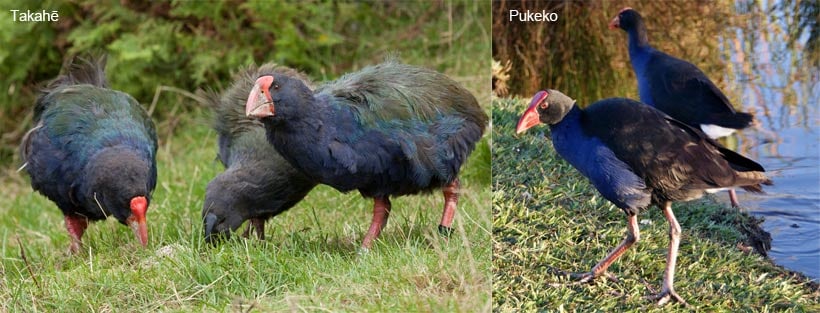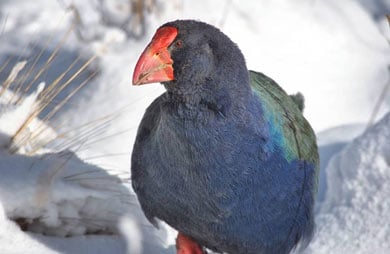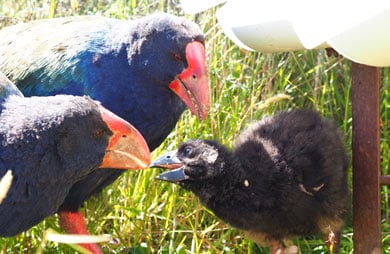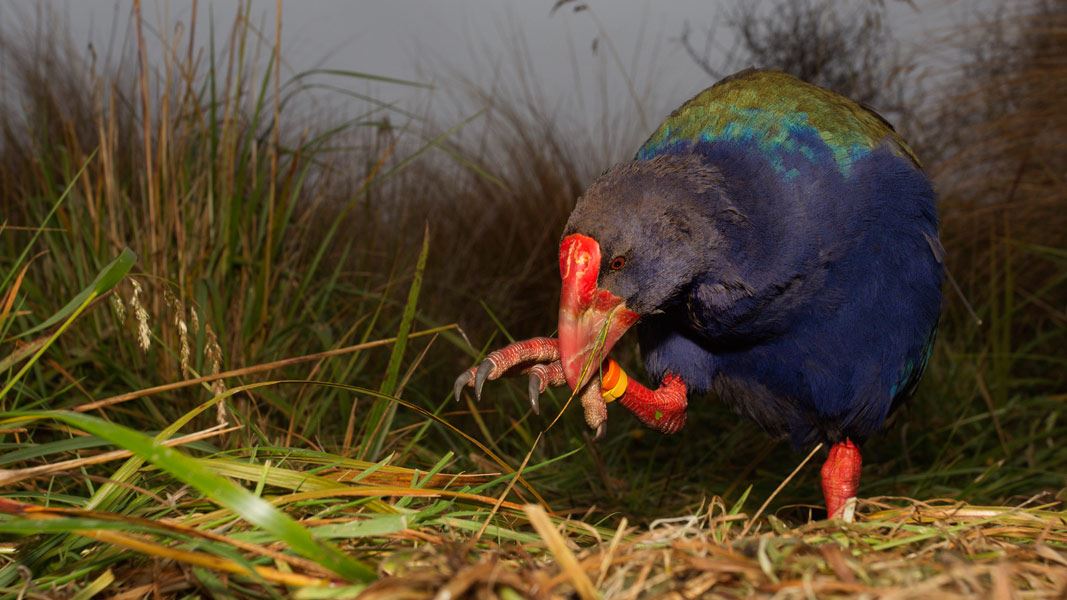Population: Around 500 as of October 2023
New Zealand status: Endemic
Conservation status: Threatened–Nationally Vulnerable
Found in: Native grasslands of Murchison Mountains, Fiordland and Gouland Downs, Kahurangi National Park, and the Greenstone Valley, Upper Whakatipu
Threats: Predation, competition for food
Sound recordings:
Takahē song (MP3, 622K)
00:38 – Takahē song.
Takahē song (MP3, 611K)
00:52 – Takahē song.
Species information: Takahē on NZ Birds Online
The flightless takahē (South Island takahē; Porphyrio hochstetteri), is the world’s largest living rail (a family of small-medium sized ground-dwelling birds with short wings, large feet and long toes). The North Island takahē (moho; P. mantelli) is unfortunately extinct.
Takahē have special cultural, spiritual and traditional significance to Ngāi Tahu, the iwi (Māori tribe) of most of New Zealand’s South Island. Ngāi Tahu value takahē as a taonga (treasure) and they continue to act as kaitiaki (guardians) of the takahē by working with DOC to protect this precious species.
Are they just fat pūkeko?
No! Although they look similar to their distant relative the pūkeko/purple swamp hen (that are common and can fly), takahē are much larger and more brightly coloured. Takahē weigh between 2.3 – 3.8 kg.

Takahē are larger with stout legs and more colours; pūkeko are blue with a black back
Image: Shellie Evans ©
Takahē have stout red legs and a large, strong red beak. Their feathers range from a dark royal blue head, neck and breast, to peacock blue shoulders, through to shades of iridescent turquoise and olive green on their wings and back. They have wings, but only use them for display during courtship or as a show of aggression.
Did you know?
Because of their highly fibrous diet, they can poo up to 9 metres a day.
Takahē only breed once a year, raising 1–2 chicks. Pairs will fiercely defend their territories. Families need a lot of space, with territories ranging between 4–100 ha, depending on the availability and quality of their food.
Takahē live for 16–18 years in the wild and 20–22 years at sanctuary sites.
In the wild, takahē inhabit native grasslands. They eat mostly the starchy leaf bases of tussock and sedge species, and also tussock seeds when available. If snow cover is heavy, they will move to the forest and feed mainly on underground rhizomes of the summer green fern.

Takahē may retreat to forest for shelter when snow is thick
Image: Servane Kiss ©

Takahē have 1 or 2 chicks a year
Image: DOC
Takahē conservation
Threats
Mammalian predators are the biggest threat to takahē. In 2007, there was a stoat plague that halved the takahē population in the Murchison Mountains.
Deer love to browse on the same tussock species as takahē do. Unfortunately, this affects tussock growth and can impact on takahē food and habitat.
Fight for survival
Takahē once roamed across the South Island, but pressures from hunting, introduced predators, habitat destruction and competition for food led to their decline.
After being presumed extinct for nearly 50 years, the takahē was famously rediscovered in 1948. Geoffrey Orbell, a physician from Invercargill and his party, found the last remaining wild population of the bird high in the tussock grasslands of the remote Murchison Mountains, above Lake Te Anau, Fiordland.
The rediscovery of the takahē launched New Zealand’s longest running endangered species programme. Since 1948, measures to ensure takahē are never again considered extinct have included pioneering conservation techniques for endangered species, captive breeding, island translocations and wild releases.
Conservation timeline
- 1948 – Rediscovered in the remote Murchison Mountains/Te Puhi-a-noa by Geoffrey Orbell and his party.
- 1985 – Burwood Takahē Centre created where wild eggs were artificially incubated and puppet reared before being returned to the wild population.
- 2010 – Puppet rearing stopped, moved to model of captive parent-raised birds at Burwood and sanctuary sites.
- 2018 – Reintroduced takahē into Kahurangi National Park with hope of establishing a second wild population.
- 1981 – Focus on natural history until population decline noted, lowest recorded population number.
- 1980s to 90s – Focus on establishing security population on four predator free islands (Te Hoiere, Mana, Kapiti and Tiritiri Matangi).
- 2007 – Large stoat plague event leads to the Murchison Mountain population being halved.
- 2016 – Total takahē population reaches 300. Population recovery finally back to pre-2007 stoat plague level and consistent population growth.
- 2018 – Reintroduced takahē into Kahurangi National Park with hope of establishing a second wild population.
- 2023 – Takahē population reached 500 and takahē are returned to the wild in the Upper Whakatipu, on Te Rūnanga o Ngāi Tahu whenua, Greenstone Station to establish a second wild population.
Takahē Recovery Programme

Today takahē are classified as Nationally Vulnerable, with a population of around 500 birds.
DOC's dedicated Takahē Recovery Programme is working hard to grow this number and establish self-sustaining wild populations within their former range, the native grasslands of the South Island.
You can help
Through the Takahē Recovery Programme, you can help by sponsoring a takahē, visiting a sanctuary site, and keeping up to date with conservation work.
